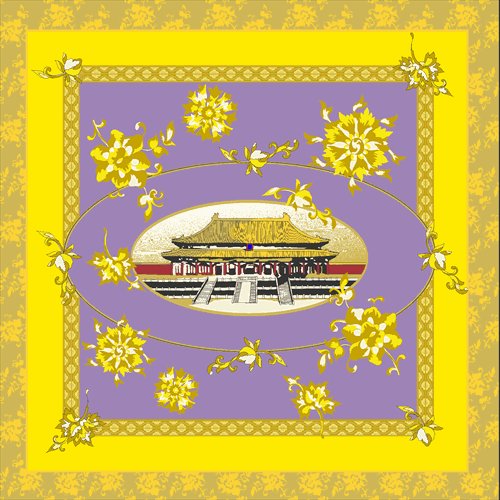
A scarf featuring the Taihe Palace from the scarf series designed for the Palace Museum by Caroline Xue and her team. (Photo/Courtesy of MARJA KURKI Fashion)
A post about international brands launching special designs for the coming Chinese lunar new year, the Year of the Monkey, has sparked heated discussions on Chinese social media.
"It seems as if foreigners think if they simply design a monkey, Chinese people would like them," said Zhong Ying.
Zhong, 24, is among the many Net users following the post. As a member of the Beijing Hanfu Association, she has been advocating for the hanfu (clothes of the Han people) culture for years and pays a lot of attention to modern designs with Chinese elements.
She said, at first glance, she thought the designs pictured in the post were "so ugly that they make people want to cry."
The post shows various products, including a Jaquet Droz wristwatch with a monkey design, a Louis Vuitton bracelet and a Dior necklace with monkey-shaped pendants, and an Armani limited edition foundation makeup case with the Chinese character "fu (happiness)" printed on it and a monkey imprinted on the powder inside.
Originally released on Sina Weibo on January 10, the post has been reposted almost 40,000 times and received 17,000 comments up to Monday, with most Chinese Net users saying the designs are "too ugly." A series of articles and posts with similar comments have also been circulating.
This is not the first time that the topic of "Chinese style" has made the news recently. The 2015 Met Ball also triggered great discussion on the issue. The Costume Institute Gala at Metropolitan Museum of Art, also known as the Met Ball, in New York on May 4, 2015, was China-themed with celebrities showing up at the event dressed to the theme. Some of the designs in the show received negative comments on their use of Chinese elements.
It is no secret that international brands are making more effort to appeal to Chinese consumers whose purchasing power have been growing rapidly in recent years. However, whether those attempts hit the sweet spot for Chinese consumers or show a misunderstanding of the Chinese culture is constantly under discussion.
Borrowing from the traditional
"Those monkeys resemble real monkeys too much," Zhong said. "I would prefer them shaped like the Monkey King (a fictional hero originally from the Chinese classic, Journey to the West)."
She said the Monkey King is more appreciated by the Chinese compared with ordinary monkeys because most Chinese worship Monkey King since childhood.
Another example is a series of recently released shoe designs by Nike where red Chinese characters are printed on the shoes. One pair says fa, meaning fortune, and another says fu (happiness), but Chinese Net users jestingly combined the two and said the shoes are "cursing" people to "fafu," which means to become fat.
Zhong commented on the Nike shoes, saying that the over-simplified way of printing red characters on shoes make them "look like they are from the 1970s or 1980s."
"In general, I think the aesthetic principle that foreigners have is simpler and more direct, but Chinese would prefer things that are beautified," Zhong said.
For example, born in the Year of the Goat, Zhong bought a gold sheep-shaped necklace last year. However, instead of resembling a real sheep, the fat sheep on her necklace is stylized.
When it comes to personal taste, Zhong prefers clothing and jewelry that borrow elements of Chinese clothing styles from ancient or pre-modern times, instead of simply printing or engraving some patterns. But she is disappointed to see that there is a lack of such designs.
"After all these years, most designers who use Chinese elements are only using pankou (buttons made of thread)," she said. "With thousands of years of history in clothing design, there are so many features one can borrow from in traditional Chinese clothing. There are so many kinds of fabrics. There are many ways to cut a skirt. And even for a simple chanzhilian pattern (a traditional pattern with lotuses and wavy branches), there are numerous variations."


















































